
The Athabasca River is a river in Alberta, Canada, which originates at the Columbia Icefield in Jasper National Park and flows more than 1,231 km (765 mi) before emptying into Lake Athabasca. Much of the land along its banks is protected in national and provincial parks, and the river is designated a Canadian Heritage River for its historical and cultural importance. The scenic Athabasca Falls is located about 30 km (19 mi) upstream from Jasper.
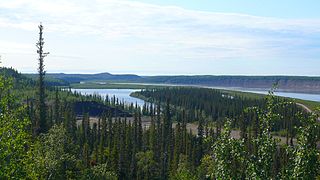
The Mackenzie River is a river in the Canadian boreal forest. It forms, along with the Slave, Peace, and Finlay, the longest river system in Canada, and includes the second largest drainage basin of any North American river after the Mississippi.

Vilhjalmur Stefansson was an Arctic explorer and ethnologist. He was born in Manitoba, Canada.

Fort Smith is a town in the South Slave Region of the Northwest Territories (NWT), Canada. It is located in the southeastern portion of the Northwest Territories, on the Slave River and adjacent to the Alberta border along the 60th parallel north.

The Slave River is a Canadian river that flows from the confluence of the Rivière des Rochers and Peace River in northeastern Alberta and runs into Great Slave Lake in the Northwest Territories. The river's name is thought to derive from the name for the Slavey group of the Dene First Nations, Deh Gah Gotʼine, in the Athabaskan languages. The Chipewyan had displaced other native people from this region.

The Radium King was built in 1937 to haul ore on the Mackenzie River, and her tributaries. This included uranium used in the US atom bombs of World War II. Later in her active career she hauled barges on Great Slave Lake.
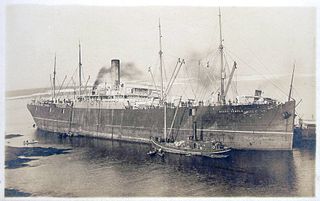
Mount Temple was a passenger cargo steamship built in 1901 by Armstrong Whitworth & Company of Newcastle for Elder, Dempster & Co Ltd of Liverpool to operate as part of its Beaver Line. The ship was shortly afterwards acquired by the Canadian Pacific Railway. It was one of the first vessels to respond to the distress signals of RMS Titanic in 1912.

The Mackenzie River in Canada's Northwest Territories is a historic waterway, used for centuries by Indigenous peoples, specifically the Dene, as a travel and hunting corridor. Also known as the Deh Cho, it is part of a larger watershed that includes the Slave, Athabasca, and Peace rivers extending from northern Alberta. In the 1780s, Peter Pond, a trader with the North West Company became the first known European to visit this watershed and begin viable trade with the Athapascan-speaking Dene of these rivers. The Mackenzie River itself, the great waterway extending to the Arctic Ocean, was first put on European maps by Alexander Mackenzie in 1789, the Scottish trader who explored the river. The watershed thus became a vital part of the North American fur trade, and before the advent of the airplane or road networks, the river was the only communication link between northern trading posts and the south. Water travel increased in the late 19th century as traders, dominated primarily by the Hudson's Bay Company (HBC), looked to increase water services in the Mackenzie River District.

Marine Transportation Services (MTS) formerly Northern Transportation Company Limited (NTCL) is a marine transportation company operating primarily in the Mackenzie River watershed of the Northwest Territories and northern Alberta, and the Arctic Ocean using a fleet of diesel tug boats and shallow-draft barges. NTCL filed for bankruptcy in 2016 and its assets were acquired by the Government of the Northwest Territories later that year.

The Radium Queen and her sister ship the Radium King were built in Sorel, Quebec in 1937, for the Northern Transportation Company, a subsidiary of Eldorado Gold Mines. The Radium Queen was a cargo/tug ship that served on the Slave River. It made runs between Lake Athabaska and Great Slave Lake which is generally navigable. The Radium Queen towed barges from the railhead at Waterways, Alberta to a portage around the rapids. Cargo was unloaded there and transported by land, and loaded on barges on the lower river that were towed by the Radium King, and later by other tugboats, like the Radium Charles, Radium Express and Radium Yellowknife.
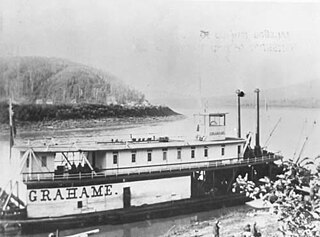
SS Grahame was a wooden sternwheeled steamship built in Fort Chipewyan, District of Athabasca, by the Hudson's Bay Company in 1882–1883 for service on the Athabasca River, lower Peace River, the Clearwater River, and the upper Slave River.

The Pilot II was a buoy tender operated by Canada's Ministry of Transport on Great Slave Lake and the rest of the Mackenzie River system in the Northwest Territories.

SS Leafield was a Canadian steel-hulled cargo ship built by the Strand Stepway Company in Sunderland, England, in 1892. Originally registered in Newcastle upon Tyne, England, she was sold after about a year to the Algoma Central Steamship Line and brought to Canada, where she operated on the Great Lakes, carrying coal, grain, and iron ore.

Aklavik was a small cargo vessel the Hudson's Bay Company used to carry supplies to, and furs from, its outposts in the high Arctic. She was active in the first half of the 20th century.

The Radium Cruiser was a Russel Brothers tugboat operated on the Mackenzie River system for the "Radium Line". She was constructed in Owen Sound, Ontario, in 1939, then disassembled and shipped by rail to Waterways, Alberta. Waterways is a river port, and was then the northern terminus of the North American railway grid. Waterways is on the Clearwater River, not far upstream from where the river empties into Lake Athabasca. The waters of Lake Athabasca flow into Great Slave Lake down the Slave River, and then down the Mackenzie River to the Arctic Ocean.

The Radium Gilbert was a tugboat built for transporting supplies to, and ore from, the radium and uranium mines in Canada's Northwest Territories. Like the other tugs in the Radium Line she was steel-hulled.
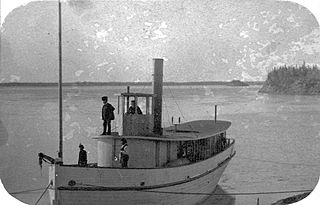
The St. Alphonse was a small steamship operated by the Brothers of the Oblate Order of Mary Immaculate, in the Northwest Territories. The order built a small fleet of steamboats to transit the Mackenzie River and its tributaries. Although fastmoving, the Mackenzie River is navigable along its entire length. But the Order required multiple vessels because some of the major tributaries, like the Peace River, Slave River had rapids that were too fast, or too shallow for navigation.

SS D.R. Hanna was a 552-foot (168 m) long American Great Lakes freighter that operated on the Great Lakes from November 12, 1906 to her sinking on May 16, 1919 after a collision with Quincy A. Shaw. D.R. Hanna was like many other freighters, and was used to haul bulk cargoes such as iron ore, coal and grain.
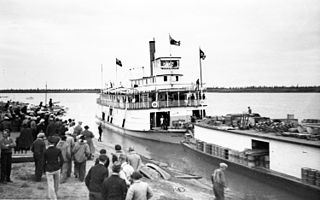
Distributor was a steamship built for service on the Mackenzie River System. The fast moving waters of the Mackenzie River, and the lower reaches of many of its tributaries, were navigable. Cargo was transported to the north on the Slave River, and had to be portaged overland over a long portage between Fort Smith and Fort Fitzgerald. Some steamship were assembled on tributaries of the Slave River, hauled by tractors over the portage, for service on the lower rivers. Distributor was larger than those vessels, and was built in the north.

The Mackenzie River was a steamship built by the Hudson's Bay Company, to transport passengers and cargo on the river of the same name.



















